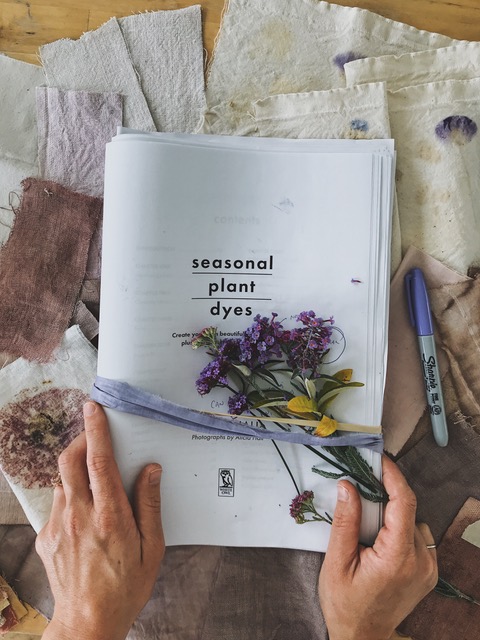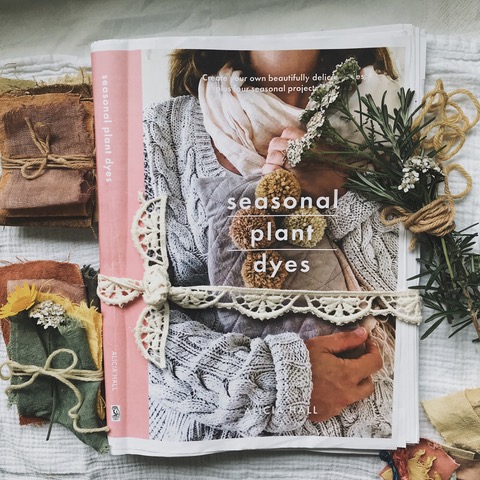Q&A Alicia Hall: Seasonal Plant Dyes
Earlier on this year my book Seasonal Plant Dyes was published. The book takes you on a seasonal journey throughout the year, showing you how to create colourful and environmentally friendly dyes using the different plants available in each season. I designed four lovely craft projects to go in the book too – a cushion cover, an embroidered picnic blanket, a hot water bottle cosy and a quilt – which I created to show off the plant dye colours beautifully. Over on my Instagram I asked you if you had any questions – about Seasonal Plant Dyes or about botanical dyeing in general – and you provided me with lots of interesting questions to answer. So lets get started.

Do you have to use soya milk to treat the fabric before you dye it or can I substitute the soya with another type of milk? What can I do with the soya milk afterwards?
The soya milk method is used to treat the fabric before it is dyed with plant colours, as it helps the dyes to stick to the fabrics and produce brighter, more vibrant colours. It’s actually the protein in the soya milk that is the magic ingredient, as it’s the protein molecules from the soya milk that bind to the fibres of the fabric which make the fabric able to absorb more plant dye particles. Technically you can use any other milk as they all have protein molecules in them (so, different nut milks and cows milk) but the only other milk that I’ve tried (and so can say with some certainty works) is almond milk. Personally i’m not planning on trying any of the other milks (the almond milk was actually an accident, I had poured the whole carton into my dye bucket before i’d realised my mistake) as the soya milk not only works really well but it’s actually the most cost effective – soya milks are normally the cheapest out of the “alternative milks” available in the supermarket and raw soya beans are much, much cheaper than raw almonds, for example.
In terms of what to do with the soya milk afterwards, you can actually use the same bucket of soya milk more than once to treated several pieces of fabric. The important thing to note is that you need to use it before it curdles, which can happen due to it ether being out in the air too long or because it has got too hot. Once your soya milk is past its best (either because you’ve used it several times or it’s curdled) then you can simply dispose of it down the sink or use it to water plants in the garden.
If you have no soya milk does it affect the colour of avocado dyeing?
Avocado skins and stones naturally have a high tannin content, which means that they dye will stick to the fabric well so you don’t need need to use soya milk for that aspect, but you DO need to it help achieve a good depth of colour on the fabric. You can still dye fabric that hasn’t been treated with soya milk. but you will most likely get a paler colour.
I tried some of the dye recipes in your book but the depth of colour that I achieved was disappointing as it was quite pale. Was my dye too dilute?
Many plant dyes are more delicate colours that their chemical counterparts but if the colour that you achieved was the correct colour and just paler than it is shown in my book, then try to keep the fabric in the dye for longer. If need be you can keep heating and reheating the dye to give it a little encouragement. There is a section on different fabrics in my book that you may find useful as it talks about how different fabrics work with plant dyes. (Natural fabrics are always best). Also remember that thinner fabrics will look paler than thicker fabrics too. Also remember to pre wash and then treat your fabrics with soya milk before you dye them with plant colours.
Can you reduce the dye (in a similar way that you would with a gravy sauce when cooking) to intensify the colour?
Reducing the dye doesn’t necessarily intensify the colour as what it actually does is reduce the amount of water particles in it, leaving you with a liquid that has a higher concentration of dye particles to water. Although this will leave you with a liquid that looks very concentrated, you will probably have to add more water to it again so that you have enough overall liquid to soak your fabric in, which will sort of leave you back where you started before you reduced the dye. That being said, the overall process of heating and reheating the dye will usually result in the colour becoming a little more intense, so you could try that instead.
I’m interested in botanical dyeing but I live in a flat and don’t have anywhere to grow plants, have you got any advice?
Nearly all of the plants in my book can be foraged from the wild and a few of them are even considered to be weeds and ones that you might not want to grow in a garden. (Nettles, for example). So there are plenty of options for readers that don’t have anywhere to grow plants. Some of the plants that I mention in my book like Eucalyptus and Buddleja. can often grow quite large and become a bit of a pest. You might prefer to find one growing in your neighbourhood and could get in touch with the owner to ask if you could take a few piece home the next time they prune it. If you have the space in your flat then there are a few plants in my book which will do just fine living in a pot on a sunny windowsill. You might not be able to grow enough to make a big batch of dye, but one plant in a pot will usually produce enough flowers or leaves for you to experiment on smaller pieces of fabric instead.
I live in the Southern Hemisphere and was wondering if you would still recommend your book, as we are always in a different season to you!
Absolutely! Although I wrote my book with our seasons here in the UK in mind, it’s applicable to countries all over the world – you just need to switch the seasons round accordingly.
Have you ever dyed using succulents?
I know succulents are a super popular house plant at the moment but they are something that I’ve never dyed with. Since you asked this question I’ve done a lot of research but can’t find anything that suggests that they would produce a dye – but don’t take my word for it, why not experiment to see what happens? Just remember to pretreat your fabric in soya milk and to heat the dye up really slowly instead of letting it boil straight away.
What plant can I use to make a lovely pastel pink colour?
There are SO many plants that can produce lovely pastel pink shades. Madder roots, Bay leaves and St John’s Wort will all product pinkish shades, as will some varieties of Eucalyptus.
Does your book include instructions to make all of the projects? I’ve noticed that it has a quilt project in it but I’ve never made a quilt before and feel a bit daunted.
When I wrote my book I wanted to make sure it appealed to people of all crafting abilities and so I tried to make the instructions really clear and easy to follow. Admittedly, the quilt does look a little bit daunting but its actually fairly simple to make – you just have to take your time and follow the steps accordingly. If there are any aspects of the quilt project (or any of the other projects in the book) that you don’t quite understand you can always get in touch with me on Instagram and I will see what I can do to help.
I live in the US and I noticed that you live in the UK…will your book still be useful for me? Do the plants that you use in your book grow in my country too?
There may be the occasional plant that is harder to come by in countries other than the UK, but the majority of them will be easy to find in the wild or grow in your own garden. Lots of dye plants are available to purchase from specialist suppliers either as extracts or chopped up and dried, which can be used as an alternative if you are unable to get hold of the live plant. It may also be worth checking with your local florist, as they may stock the foliage or flowers you need to make a dye, as another alternative to growing it yourself or finding it growing in the wild.
When did you first discover natural dyeing and what made you love it?
To answer the first part of your question, this quote from my book sums it up perfectly: “I discovered plant dyeing during my time spent working as a gardener for the National Trust and working with a huge variety of plants in a beautiful garden meant that I was instantly hooked. The first week after I learnt that it was possible to produce colours from plants was spent collecting carrot tops during my daily produce harvests in the kitchen garden and storing them in the fridge until I had enough to dye with. That weekend was spent making carrot top dye: soaking the greenery in water overnight before leaving a cotton tote bag to sit in this magical green water, still not quite believing that it would work. To my amazement it did work and I’d managed to dye the bag a beautiful chartreuse green. I hung it up to dry, excited to show my colleagues at work the following day. This spurred the start of several months of intensive research and experimentation to really understand how plant dyeing worked.” Chapter one, Seasonal Plant Dyes
As for what made me fall in love with botanical dyeing? When I discovered it, it seemed like the perfect combination of my Fashion Design training and my work as a Gardener. I love being outdoors more than anything (it feeds my soul and makes me feel calm) but I also really like crafty and making things. Botanical dyeing just seemed to be the perfect fit.

Seasonal Plant Dyes is available to order here. Digital editions are available to download here.


